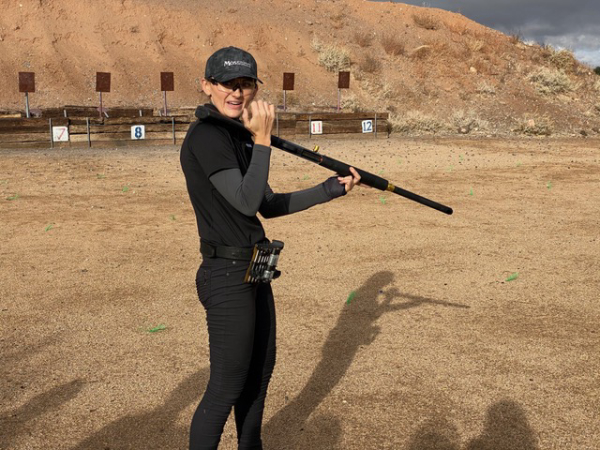Watching Lena Miculek, whether we’re chatting, sitting at dinner, or standing on a shooting range, I feel a lot like I imagine Winnie the Pooh felt watching Tigger be Tigger. She operates at a rate at which I can only marvel.
Her pace is exhausting, but her enthusiasm’s so-contagious that you don’t notice you’ve worn yourself out trying to do -slowly- what she does at rates that would leave a hummingbird huffing.

Last week, I was part of a group of writers out at Gunsite Academy to test some new guns from Mossberg. We were also fortunate enough to spend a significant amount of time -on and off the ranges- with Mossberg professional shooters Jerry and Lena Miculek.
Having been coached by Jerry in the past, I knew he would give us solid coaching that would be based on his assessment of our individual abilities.
With high-level shooters like Chris Cerino and Jeff Krambit, he would offer subtle suggestions that help trim hundredths of seconds off their shooting times. For me, it’s more gross motor skills. Things like “try to find the sights before yanking the trigger.”
Having not watched Lena teach, I didn’t quite know what to expect. But I had pretty high expectations.
After all, she’s the daughter of two of this generation’s best shooters (Jerry and Kay Clark Miculek). They also happen to be a pair of the most effective teachers/coaches I’ve ever known in any sport.
I knew she was good people and a champion shooter.
But I was blown away by how well she could teach. Granted, she’s grown up under the tutelage of a pair of masters at shooting and instruction. But a 24-year old who can break the complicated action of loading a shotgun at high speed down into easy-to-chew bites is unique.
She’s no mashup of her Mom or Dad’s teaching styles. Hers is a decidedly “Lena” approach . It’s unique to Lena.
Before she even starts teaching, she tosses out a concept that’s completely heretical to many “instructors”.
“There is no right way or wrong way to do anything,” she smiles, “you need to find out what’s ‘right’ for yourself, and you need to question everything you do and everything anyone tells you.”
“OK,” she continues, “always listen to everyones advice, tips, tricks, whatever, but it’s up to you not to take it and just decide that’s what I’ll do.”
“You have to question it all,” she says, “you figure out if there’s a benefit for you. Then you pick-and-choose what works for you. Don’t be afraid to modify someone else’s techniques to be yours. That’s where true gains are made.”
“I can teach you a grip,” she explained, “or I can tell you what your goals are with a grip- recoil control, keeping the sights down, weight forward and all those things. Then you can create a grip that works - it’s your grip.”
She wants her students to be unique.
Watching her tell a very large guy in our group that all he needed to do was to develop a position where he standing comfortably when shooting his shotgun was impactful. Especially -after she’d just gone in depth to explain how her size (or lack thereof) forced her to be extremely aggressive in her shooting position in order to manage a 12 gauge’s recoil. She really believes that “unique” thing she teaches.
Off the range, I asked her how her philosophy impacts her practice time.
Her answer took me by surprise.
“When I first go to the range,” she laughed, “I tell myself I know nothing, everything I do is wrong, and there’s got to be a better way. Then I look at everything I do - with the goal of stripping out any unnecessary movement.”
Lena’s approach proves to me- again- that good coaches break you down and force you into their mold. Great coaches take what you have and enable you to take those abilities to higher levels than you might dream possible.
There’s no need to be concerned that the skillsets down on Shooters Lane in Princeton, Louisiana are diminishing. They may moving into a younger generation, but they’re not going anywhere.
—Jim Shepherd